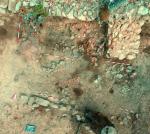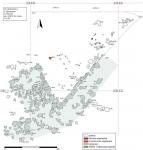Summary (English)
EXPLORATIONS NEAR THE VILLAGE OF BRODILOVO (Deyan Dichev – dejan.dichev@abv.bg) In Sector West, the drain was explored in Trenches Zh 5/6 and Z5. In Sector Center, sherds, a quern, a terracotta spindle whorl and a bronze coin of Probus were discovered in Trench Z8. Room No. 4 was explored in Trenches E10/Zh10–11, situated along the northern fortification wall. A pilaster adjoining the fortification wall was discovered. A hoard of 16 bronze coins, mostly of the Thracian King Mostis (113 – 85 BC), placed in a small ceramic jug, was discovered on the floor of the room. Sherds from a ceramic rhyton ending with a protome of a deer/hind, a fragmentary ceramic vessel with carbonized wild pears, sherds and a bronze nail were also found. The debris of the northern fortification wall was excavated in Trench E10. The floor of Room No. 4 was discovered beneath and fragmentary burned wattle-and-daub, fragmentary ceramic vessels (cups, jugs, dolia, pots and amphorae), terracotta spindle whorls, terracotta loom weights, a terracotta lamp and a concentration of carbonized wheat and millet. Some of the dolia contained carbonized wheat. The larger ceramic vessels were placed along the walls of the room, while the smaller ones, such as cups and jugs, were arranged in front of them. A clay eschara was discovered in the center of the room and three small terracotta cult objects (an anthropomorphic-zoomorphic figurine, a model of an altar and a star-like object) were found close to it. The northern floor level of the room was c. 15 cm lower than the southern one. In Sector East, a sector of the eastern fortification wall, 1.10 m wide, was discovered in Trench E12. A layer containing carbonized grain, fragmentary burned wattle-and-daub and an Olynthus mill was discovered beneath the debris situated outside the fortified area. The Thracian tyrsis (residential tower) dated to the end of the 2nd – first quarter of the 1st centuries BC.
- Deyan Dichev - Archaeological Institute with Museum
Director
- Deyan Dichev - Archaeological Institute with Museum
Team
Research Body
- Archaeological Institute with Museum






![Download [PDF]](/excavation/skins/fasti/images/results/download_sml.png)
